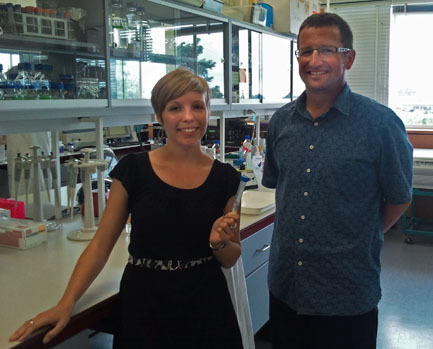
Postdoctoral research scientist Jo Hobbs and Vic Arcus with a test tube of the ancient enzyme (image: V. Meduna)
Waikato University molecular biologists Vic Arcus and Jo Hobbs have reconstructed an ancient enzyme, reaching back a billion years to a very different world. They used new computational techniques to make accurate predictions about the size, three-dimensional shape and amino-acid sequence of an enzyme from a Precambrian ancestor of a modern Bacillus bacterium. Apart from the billion-year-old enzyme, they also created analogues that trace the evolution of the organism to the present day.
The ancient enzyme, the most complex and one of the most ancient proteins that has been recreated so far, proved to be very stable and active at high temperatures - seven times more active than a comparable modern enzyme and stable up to 70 degrees Celsius. This means that the billion-year-old Bacillus ancestor most probably lived in a hot and inhospitable environment. At the time, photosynthesis had already evolved but the oxygen levels in air were far lower than today. The world was largely microbial, with some early eukaryotic life forms. During the evolution of these bacteria, they adapted to a range of temperatures, and are now found in nearly every possible environment, from hot pools to garden soils, lakes and even in Antarctica. The findings are published in the Journal of Molecular Biology and Evolution.

